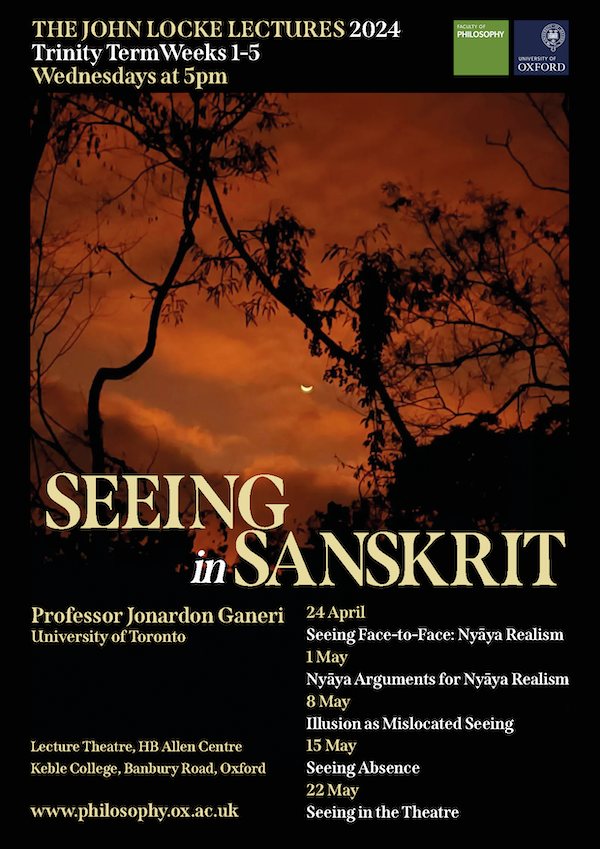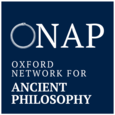The 2024 John Locke Lectures: Seeing in Sanskrit
Professor Jonardon Ganeri (University of Toronto)
The Faculty is most delighted to welcome Professor Jonardon Ganeri as the John Locke lecturer of 2024. Jonardon is Professor of Philosophy at the University of Toronto, and will give a series of lectures in Trinity Term 2024.
The lectures will take place at 5pm on Wednesdays in weeks 1 to 5 of Trinity Term 2024 (24 April and 1, 8, 15, 22, May), at The HB Allen Centre, 25 Banbury Road, Oxford.
The Reading List for the lectures is available here.
Lecture Series Synopsis
My plan for this series of lectures is as follows. In the first lecture I will offer a fresh reading of a key early Nyāya text. My aim will be to demonstrate a way of understanding the text which frees it from a gloss put on it by later interpreters, a conceptualist gloss that eventually binds it to a thesis incompatible with naïve realism or relationalism. In the second lecture I will examine key Nyāya arguments for Nyāya realism, the most important of which is that amodal perception of wholes is better explained with its framework than within Buddhist representationalism. I then turn to three forms of experience that enrich the picture. The first is illusion, and my argument in the third lecture will be that neither disjunctivism nor objective looks theory is more compelling than the Nyāya’s own explanation of perceptual error. This explanation draws on synaesthetic phenomena to defend the existence of anomalous relations of acquaintance with absent features. The second case is absence experience, the best noninferential theory of which concedes a role to mental imagery. Even a dogged commitment to absence realism cannot help Nyāya here. The view I defend is a non-disjunctivist version of naïve realism, one in which the relation of presentation is enriched to include both the presentation-as-present of absent features and the presentation-as-absent of absences through mismatch with mental imagery. The third case is the spectatorial experience of artworks. A sophisticated Indian analysis of such experience, as it relates to audience engagement in theatre (rasa), leads me to a threefold analysis in which the perception of an artwork incorporates elements both of virtual acquaintance and absence experience (prominent in aniconic representation). In all this my aim is to reprise Wollheim’s “two perceptual projects” hypothesis but in a different form. What replaces the distinction between seeing face-to-face and seeing-in is an orthogonal one, between what is presented-as-present and what is presented-as-absent. I will focus on the relationship between perceptual experience and attention. We have been taught by Richard Wollheim that the perceptual experience of an artwork consists in a twofold attention, and by Krishnacandra Bhattacharyya that the perceptual experience of absence consists in a negative attention (a figure-ground structure with an empty figureposition). Attention explains how we can experience wholes and why there are illusions, and I want to resist the view that what does the explanatory work is the thesis that perceptual experience is saturated by concepts and conceptualisation. So I will argue that a suite of Sanskrit ideas are better understood as matters of attention rather than conceptualisation: savikalpaka-pratyakṣa (the idea of perceptual structure), avayavi-pratyakṣa (perceptual completion in the perception of whole objects), viparyaya (the idea of perceptual error and illusion), abhāva-pratyakṣa (absence perception), and finally rasa (aesthetic experience as perceptual). The key concepts I will draw upon from the psychology and philosophy of attention are: the distinction between selection and access, the idea of a perceptual chunk, feature-binding, the figure-ground distinction, and simultaneous divided attention. So I argue for a non-disjunctivist version of naïve realism, inspired by the work of Bimal Matilal but extending it. In an update of the empiricist project it is to Nyāya rather than Locke that we should look.
Please note that at each lecture seats will be offered on a first come first served basis. Once maximum capacity is reached and/or the lecture has begun admission will not be possible. We therefore recommend arriving in plenty of time to increase your chances of getting a seat.

Lectures
Lecture 1: Seeing Face-to-Face: Nyāya Realism
In the first lecture I reflect on Bimal Matilal’s brilliant reconstruction of Nyāya philosophy of perception as a version of naïve realism, and I offer a new interpretation of a foundational statement in the philosophy of perception in classical India: Nyāya-sūtra 1.1.4.
Texts: Nyāya-sūtra 1.1.4 & commentaries (Thakur 1997); Matilal 1986.
Readings: Genone 2016, Steenhagen 2019, Logue 2012, Campbell 2014, Chadha 2024.
Lecture 2: Nyāya Arguments for Nyāya Realism
I identify two central Nyāya arguments in favour of their version of naïve realism, which I call the argument from selection and the argument from (amodal) completion. Of these the first serves to diffuse a Buddhist counter-argument in support of representationalism, while the second argues that naïve realism is the best explanation of our ability to perceive wholes.
Texts: Vaiśeṣika-sūtra 4.1.6–9 (Thakur 1985); Nyāya-sūtra 2.1.31-5 & commentaries (Thakur 1997).
Readings: Matilal 2002c, Millar 2015, Briscoe 2018, Nanay 2010, Nanay 2022, Dunne 2020.
Lecture 3: Illusion as Mislocated Seeing
The two leading naïve realist accounts of illusion are disjunctivism and objective looks theory. I argue that Nyāya provides a third account of illusion, namely, that illusions result from feature-binding misfires involving relations of anomalous acquaintance with absent features. Insights about feature-binding will be drawn from the psychology of synaesthetia.
Texts: Nyāya-sūtra 4.2.35-7 & commentaries (Thakur 1997).
Readings: Vaidya 2013, Dasti 2012, Antony 2011, Kalderon 2011, Brewer 2011, Genone 2014.
Lecture 4: Seeing Absence
What is the nature of our experience of absence? I draw on the work of Krishnachandra Bhattacharyya, and provide a new explication of his concept of negative attention. I reprise Wollheim’s “two perceptual projects” hypothesis, between seeing face-to-face and seeingin, but reconfigure it in terms of a distinction between what is presented-as-present and what is presented-as-absent. Aniconic representation affords an example.
Text: Bhattacharyya 1930, ch.4.
Readings: Farennikova 2013, Cavedon-Taylor 2017, Martin & Dokic 2013, Wollheim 1980.
Lecture 5: Seeing in the Theatre
Sanskrit aesthetics is, in the first instance, a theory of rasa: audience experience in theatre. Against the dominant view that such experience consists in noncognitive affect, I examine that of the philosopher Srī Śaṅkuka (fl. 859 CE), who offers instead an analysis of audience engagement as the perceptual experience of characters and staged emotions.
Text: Abhinava-bhāratī 1992, 276-82 (= Gnoli 1968).
Readings: Lopes 2005, Nanay 2018, Pollock 2016: 77–83, Shulman 2012: 63-5, Nanay 2018, Wollheim 1998.




